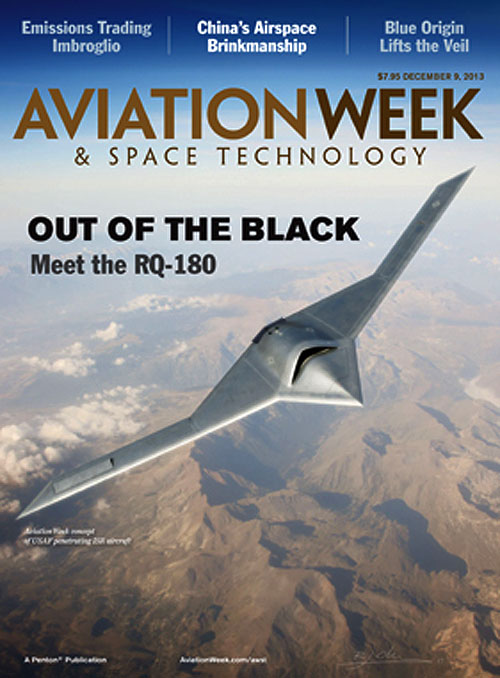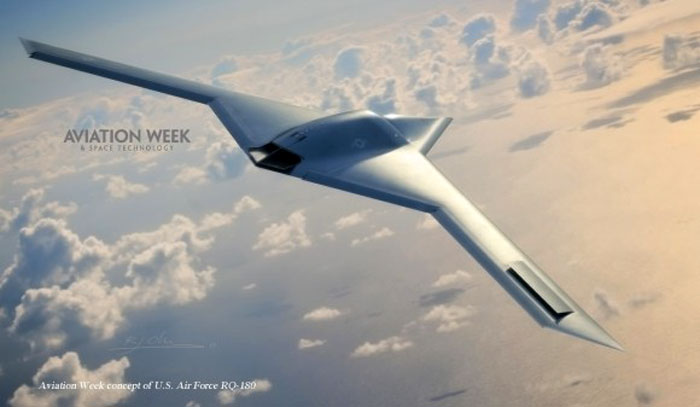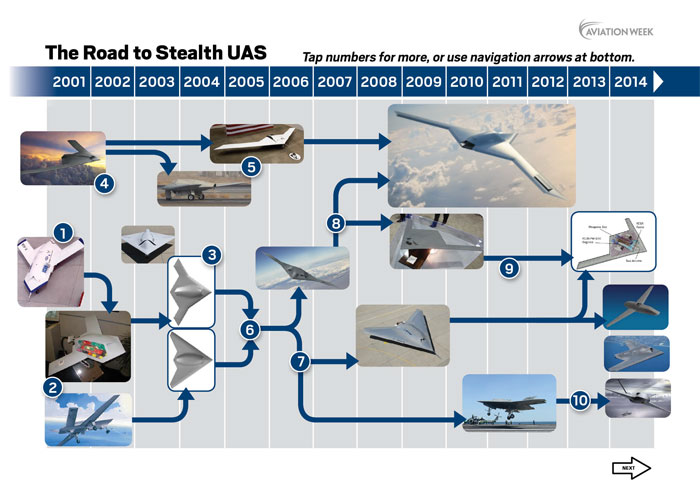.
A large, classified unmanned aircraft developed by Northrop Grumman is now flying—and it demonstrates a major advance in combining stealth and aerodynamic efficiency. Defense and intelligence officials say the secret unmanned aerial system (UAS), designed for intelligence, surveillance and reconnaissance (ISR) missions, is scheduled to enter production for the U.S. Air Force and could be operational by 2015.
Funded through the Air Force’s classified budget, the program to build this new UAS, dubbed the RQ-180, was awarded to Northrop Grumman after a competition that included Boeing and Lockheed Martin. The aircraft will conduct the penetrating ISR mission that has been left unaddressed, and under wide debate, since retirement of the Lockheed SR-71 in 1998.
Neither the Air Force nor Northrop Grumman would speak about the classified airplane. When queried about the project, Air Force spokeswoman Jennifer Cassidy said, “The Air Force does not discuss this program.”
The RQ-180 carries radio-frequency sensors such as active, electronically scanned array (AESA) radar and passive electronic surveillance measures, according to one defense official. It could also be capable of electronic attack missions.
This aircraft’s design is key for the shift of Air Force ISR assets away from “permissive” environments—such as Iraq and Afghanistan, where Northrop Grumman’s non-stealthy Global Hawk and General Atomics’ Reaper operate—and toward operations in “contested” or “denied” airspace. The new UAS underpins the Air Force’s determination to retire a version of the RQ-4B Global Hawk after 2014, despite congressional resistance. The RQ-180 eclipses the smaller, less stealthy and shorter-range RQ-170 Sentinel.
If the previous patterns for secret ISR aircraft operations are followed, the new UAV will be jointly controlled by the Air Force and the CIA, with the program managed by the Air Force’s Rapid Capabilities Office and flight operations sustained by the Air Force. This arrangement has been used for the RQ-170, which is operated by the Air Force’s 30th Reconnaissance Sqdn., according to a fact sheet the Air Force released after one of the aircraft turned up in Iran.
Northrop Grumman’s financial reports point to a possible award of a secret UAS contract in 2008, when the company disclosed a $2 billion increase in the backlog in its Integrated Systems division. This is the operating unit responsible for building the B-2 bomber, Global Hawk and Fire Scout UAS and X-47B unmanned combat air system (UCAS) demonstrator. This year, Northrop Grumman financial reports acknowledged that an unnamed aircraft program entered low-rate initial production, the Pentagon term for low-volume deliveries that begin as testing nears completion and before the program is approved for full production.
Beyond the financial disclosures, publicly available overhead imagery shows new shelters and hangars sized for an aircraft with a 130-ft.-plus wing span at Northrop’s Palmdale, Calif., plant and at Area 51, the Air Force’s secure flight-test center at Groom Lake, Nev.
The company also pushed for a substantial expansion of its Palmdale production facilities in 2010, perhaps to support work on the RQ-180 (AW&ST Nov. 22, 2010, p. 28).
.

The new aircraft’s existence explains an inconsistency: Air Force officials have frequently called for a new, penetrating ISR capability. Yet there has been no public evidence that the service has been planning to develop such an aircraft.
At a House Armed Services Committee hearing in April, Lt. Gen. Charles Davis, the Air Force’s top uniformed acquisition official, said the service has no requirement for more Global Hawks beyond 2014 and wants to “use that money for much higher priorities.”
Defending the planned cuts to the Global Hawk, Davis said, “We did not do that without carefully looking at how we cover that [mission] with the U-2 and other classified platforms.” But when asked during the open congressional hearing to explain, he said, “You’d probably need to go into detail within another forum.”
In September, Lt. Gen. Robert Otto, the Air Force deputy chief of staff for ISR, said the service’s “first priority” in intelligence, surveillance and reconnaissance is “to rebalance and optimize our integrated ISR capabilities.
“The mix is not where it needs to be,” he said. “We are over-invested in permissive ISR and we have to transform the force to fight and win in contested environments. We will seek a more balanced fleet of both manned and unmanned platforms that are able to penetrate denied airspace and provide unprecedented levels of persistence.”
The Air Force could not afford to buy and maintain the target number of 65 MQ-9 Reaper and MQ-1 Predator combat air patrols beyond 2014, Otto added, possibly pointing to a shift in priorities to the new Northrop system.
These public statements are a byproduct of an internal debate over the number of the new secret UAS to be acquired. While there is apparently agreement on the need for a small “silver-bullet” force for special military and CIA missions, a larger fleet could be an enabler for fighters and bombers against a wide range of targets. A 2009 report by the influential think tank the Center for Strategic and Budgetary Assessments recommends a force of five 10-aircraft squadrons of high-altitude, stealthy, ISR unmanned penetrators. But such a large fleet would be costly and could compete for funding with the Joint Strike Fighter, the Long-Range Strike Bomber and other high-priority programs.
In addition, if the U.S. procures more than a few of the secret RQ-180 aircraft, it will be harder to keep them under wraps. Historically, the Air Force has resisted establishing operational units at Area 51, its most secure known operating base, because maintaining compartmentalization there between multiple secret programs becomes difficult. For example, workers are usually confined to their buildings when a classified program other than their own is performing tests outside. The disruption to work grows if one program is running at an operational tempo.
In April, Otto’s predecessor as deputy chief of staff for ISR, Lt. Gen. Larry James, acknowledged that the Air Force had learned lessons about the need to more widely disseminate information on classified programs to ensure operational commanders are fully aware of their capabilities. Responding to a question from Aviation Week at a Stimson Center event in Washington, James said, “We have a whole host of programs covering all the different environments, and we ensure that as we develop new capabilities we are in conversations with people at the right levels. We are much better today than we were 10-15 years ago, [when] you’d have this new super-secret thing and you’d turn up at the combatant commander’s door at the start of an operation. That’s not a good place to be.”
The RQ-180 has its roots in Northrop Grumman’s Joint Unmanned Combat Air System (J-UCAS) project. The main reason for J-UCAS’s cancellation in late 2005 was the divergence in requirements. The Navy wanted a carrier-based aircraft, which led to the X-47B program. The Air Force sought a larger, longer-range “global strike enabler” that would be much more capable than the RQ-170, which was then being developed.
A fiscal 2007 Navy budget document disclosed that the J-UCAS program had been split in December 2005 into a Navy demonstration effort (which led to the X-47B) and “an Air Force classified program.” At the same time, Northrop openly discussed a range of longer-winged X-47C configurations, the largest being a 172-ft.-span design with two engines derived from General Electric’s CF34 and capable of carrying a 10,000-lb. weapon load.
The RQ-180 is smaller than that concept, and it is not clear whether it will conduct strike missions. It is similar in size and endurance to the Global Hawk, which weighs 32,250 lb. and can stay on station for 24 hr. 1,200 nm from its base. The much smaller RQ-170 is limited to 5-6 hr. of operation.
A key feature of the RQ-180’s design is an improvement in all-aspect, broadband radar cross-section reduction over Lockheed Martin’s F-117, F-22 and F-35. This is optimized to provide protection from low- and high-frequency threat emitters from all directions. The design also merges stealth with superior aerodynamic efficiency for increased altitude, range and time on station.
The aircraft uses a version of Northrop’s stealthy “cranked-kite” design, as does the X-47B, with a highly swept centerbody and long, slender outer wings. Northrop Grumman engineers publicly claimed (before the launch of the classified program) that the cranked-kite is scalable and adaptable, in contrast to the B-2’s shape, which has an unbroken leading edge. The RQ-180’s centerbody length and volume can be greater relative to the vehicle’s size.
Computational fluid dynamics permit new stealth aircraft to achieve “sailplane-like” efficiency, industry officials say. The management of complex three-dimensional airflow is the key to achieving laminar flow over much of the wing and designing stealth-compatible exhaust and inlet systems that are lighter and more efficient than those on the B-2.
Aerodynamics and stealth are often at odds. The B-2’s “toothpick” leading edges—sharp at the nose and wingtip and blunter in between—are the result of a hard-fought trade-off between the team trying to optimize aerodynamic performance and the group concerned with making it hard to detect. Maintaining a high degree of laminar flow on a swept wing is an achievement in itself, because spanwise air flow tends to induce turbulence and is not made any easier by possible spillage from overwing inlets.
The pursuit of laminar flow and efficiency likely drove the development of new structural and manufacturing technologies. Scaled Composites, which Northrop Grumman acquired in 2007, is a world leader in building large composite airframes “outside-in” in female molds, resulting in a consistent and fastener-free surface.
Engine integration always presents challenges for stealthy designs. The length and volume of the serpentine inlet and exhaust systems (used to shield metal engine components from radar) are proportional to engine diameter, because the duct curvature radius must increase with its area to avoid distortion. Also, higher-bypass engines, which are larger in diameter, tend to be less tolerant of flow distortion than low-bypass types. This is one reason why most subsonic stealth aircraft, including the B-2, use adapted fighter engines at a significant penalty to fuel economy.
The RQ-180 could use a medium-bypass-ratio engine, similar to the modified CF34 engine eyed for early X‑47-based concepts. Its engine probably has more power than the Global Hawk’s 7,600-lb.-thrust Rolls-Royce AE3007H, to provide better altitude performance and electrical power for payload growth.
Operationally, the RQ-180’s range could be extended by inflight refueling, though it is unclear whether the UAS takes advantage of this technology. Before 2008, Northrop Grumman repeatedly stated its belief that the endurance of an X-47-based aircraft could be pushed to 100 hr. with refueling. Beyond that point, the need to reengineer components to extend the time they could be flown between inspections was predicted to be burdensome. The limiting factor on Global Hawk endurance beyond its onboard fuel capacity is oil life.
The Navy pursued probe-and-drogue refueling under the X-47B program, but it used a manned surrogate aircraft for flight tests. The Air Force separately conducted tests in 2008 using its boom-equipped tankers and a manned surrogate, but after 2008, no progress with boom refueling of unmanned aircraft was reported publicly.
Incorporating advances in stealth and aerodynamics, the RQ-180 shows that low-observable technologies can still adapt to counter new threats such as low-frequency radar. It is a stepping-stone to the development of the Air Force’s Long Range Strike Bomber, while also complementing the B-2 and other long-range strike assets. By contrast to its predecessors, the RQ‑180 secures a foothold for stealth in future war plans, in which extremely expensive “do everything” platforms are eclipsed by families of networked, cooperative systems.
Quelle: Aviationweek
.

X-47B
.

RQ-180
.

Quelle: Aviationweek
5511 Views
